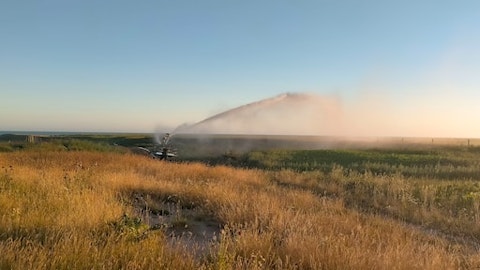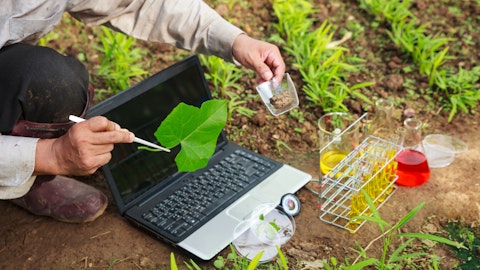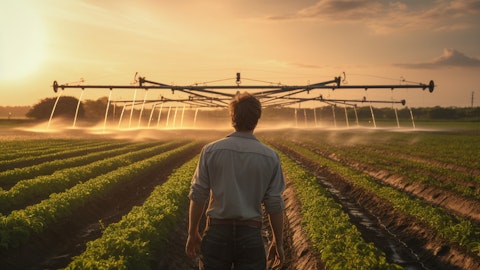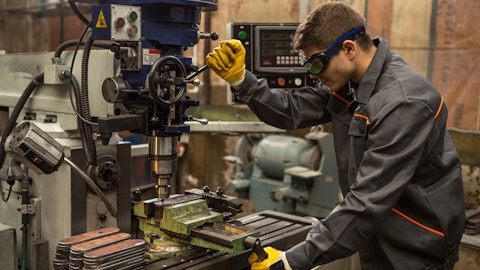Lindsay Corporation (NYSE:LNN) Q2 2024 Earnings Call Transcript April 4, 2024
Lindsay Corporation beats earnings expectations. Reported EPS is $1.64, expectations were $1.56. LNN isn’t one of the 30 most popular stocks among hedge funds at the end of the third quarter (see the details here).
Operator: Hello, and welcome to the Lindsay Corporation Fiscal Second Quarter 2024 Earnings Conference Call. All participants will be in listen-only mode. [Operator Instructions] After today’s presentation, there will be an opportunity to ask questions. [Operator Instructions] As a reminder, this conference is being recorded. I would now like to hand the call to Randy Wood, President and CEO. Please go ahead.
Randy Wood: Thank you, and good morning, everyone. Welcome to our fiscal 2024 second quarter earnings call. With me today is Brian Ketcham, our Chief Financial Officer. I am pleased with the consolidated performance and resilience of our business through the first-half of this fiscal year. While market conditions in South America have temporarily impacted activity across the agriculture industry, the performance of our North American irrigation business continues to be supported by steady demand amid tempered grower sentiment. Additionally, in our Infrastructure business, the continued mix shift towards leasing for our leading Road Zipper System is delivering meaningful margin expansion. Overall, I am encouraged by our ability to execute operationally and strategically in order to drive profitability across the organization, as well as the actions we’ve taken to navigate suboptimal market conditions in some regions.
In North America, our Irrigation business saw comparable whole goods demand versus the second quarter of last year, which was largely in line with expectations, and supported by the carryover impact of sold farm profits from last year. While stable demand in North American end markets has supported our year-to-date revenue results, we are approaching the back-half of the year with tempered expectations. The USDA recently released its initial 2024 net farm income projections, which were significantly below initial market forecasts and expectations. While this has the potential to negatively impact farmer sentiment and the deployment of investment dollars for new equipment in the near-term, it’s still very early in the season. Moving to international irrigation, where we continue to see a softening of demand.
In particular, the Brazilian market has experienced reduced grower profitability, limited access to financing, and constrained investment capacity. While we’re facing a challenging external operating environment in Brazil in the near-term, we’re still very confident in the mid to long-term opportunities in this market. Ongoing droughts in São Paulo, Mato Grosso do Sul, and Paraná have increased state-level support for irrigation. And with low penetration levels and the ability to support up to three crops per year, these markets will continue to grow. Moving to Infrastructure, as I mentioned in my opening remarks, our overall profitability continues to benefit from the strong growth of our Road Zipper System leasing business, an encouraging indicator as we move forward.
Despite revenue that was comparable to the prior-year period, we captured meaningful margin improvement that Brian will touch on later. We expect continued growth in our Road Zipper lease revenue in the back-half of this year as we move into the heart of the road construction season, coupled with the strong backlog in sales pipeline for the overall infrastructure business. Additionally, as we’ve mentioned in prior calls, we expect our infrastructure business to benefit over time as U.S. infrastructure spending ramps up as part of the Infrastructure Investments and Jobs Act. We’ve only recently begun to see that dynamic play out, and we believe that we’re in the early innings of a multiyear growth trajectory for infrastructure spending domestically.
Turning to innovation and technology, as we announced yesterday, we’ve agreed to acquire a 49.9% interest in Pessl Instruments, with an option to acquire the remainder of the company in the future. Pessl is a leading developer and distributor of in-field monitoring solutions for agricultural markets. The company deploys software and IoT hardware, including weather stations and environmental sensors, supporting agricultural decision-making including pest and disease control, crop management, and irrigation management. We believe this relationship further highlights our commitment to providing world-class water management solutions to growers around the globe. Our combined platforms and integrated technologies will allow users to monitor and adjust irrigation operations based on key atmospheric conditions, while also enhancing overall predictive analytics capabilities.
This further strengthens our digital water management portfolio, allowing us to reach a broader set of customers and service providers globally. Lastly, I’d like to address our recent announcement to expand and modernize our manufacturing facilities. In January, we announced our commitment to invest more than $50 million over the next two years to implement state-of-the-art technology that will greatly benefit our global operations. Our strategic plans for the modernization of our facilities include the implementation of Industry 4.0 Technologies, data connectivity, analytics, artificial intelligence, and the addition of automation and robotics. Our renovated facility will also house new equipment and the latest advancements in galvanizing a core process for manufacturing mechanized irrigation systems and road safety products.
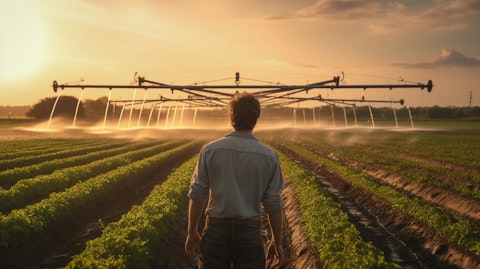
Additionally, we’ll be expanding our Lindsay, Nebraska facility by 40,000 square feet to allow for increased manufacturing capacity and capabilities and metal forming. This investment is the largest in our company’s history and we look forward to updating you as we invest further into operational excellence and innovation. I’d like to turn the call over to Brian to discuss our second quarter financial results. Brian?
Brian Ketcham: Thank you, Randy, and good morning everyone. Consolidated revenues for the second quarter of fiscal 2024 were $151.5 million, a decrease of 9% compared to $166.2 million in the prior year. The decrease resulted from lower irrigation segment revenues, as infrastructure revenues were comparable to the prior year second quarter. Net earnings for the quarter were $18.1 million or $1.64 per diluted share, compared to net earnings of $18.1 million or $1.63 per diluted share in the prior year. The impact of lower revenues and lower operating income was favorably offset by an increase in other income and a lower effective tax rate compared to the prior year’s second quarter. Other income benefited from increased interest income and favorable foreign currency translation results compared to the prior year’s second quarter.
And income tax expense for the quarter was reduced by the realization of a one-time tax benefit of $1.1 million in Brazil. Turning to our segment results, Irrigation segment revenues for the quarter were $133 million, a decrease of 10% compared to $147.8 million in the prior year. North America Irrigation revenues of $82.8 million decreased 8% compared to $90.4 million in the prior year’s second quarter. Most of the decrease resulted from lower sales of replacement parts, along with slightly lower average selling prices and the impact of a less favorable mix of shorter machines compared to the prior year second quarter. Sales of replacement parts in the prior year included a substantial number of MODEM and RTU upgrades connected to the sunsetting of 3G coverage that did not repeat this year.
While overall selling prices in North America remained relatively stable during the quarter, we did see selective competitive discounting in some regions that we responded to. The impact of these revenue decreases was partially offset by moderately higher unit sales volume compared to the prior year’s second quarter. In International Irrigation markets, revenues of $50.2 million decreased 13%, compared to revenues of $57.4 million in the prior year’s second quarter. The decrease resulted primarily from lower revenues in Brazil and other Latin American markets compared to the prior year, while the impact of increases and decreases in other markets mainly offset one another. In Brazil, a 20% drop in cash soybean prices from December to February coupled with lowered yield expectations is negatively impacting the outlook for grower profitability and available liquidity as growers are indicating an unwillingness to sell their crops at current price levels.
This situation is also resulting in a more constrained credit environment, which is also limiting investment in irrigation equipment in the near-term. Irrigation segment operating income for the quarter was $25.6 million, a decrease of 22% compared to the prior year. And operating margin was 19.3% of sales compared to 22.2% of sales in the prior year. Lower operating income and operating margin resulted primarily from lower revenues and the resulting impact from deleverage of fixed operating expenses. Infrastructure revenues for the quarter were $18.5 million and were comparable overall to the prior year. An increase in Road Zipper System lease revenues was offset by lower Road Zipper System project sales, and lower sales of road safety products compared to the prior-year second quarter.
Infrastructure segment operating income for the quarter was $3.5 million, an increase of 74%, compared to $2 million in the prior year. Infrastructure operating margin for the quarter was 19% of sales, compared to 10.9% of sales in the prior year. The increase in operating income and operating margin resulted from a more favorable margin mix of revenues, with higher Road Zipper System lease revenues compared to the prior-year second quarter. Turning to the balance sheet and liquidity, our total available liquidity at the end of the second quarter was $200.6 million, which includes $150.6 million in cash, cash equivalents, and marketable securities, and $50 million available under our revolving credit facility. Year-to-date cash generated from operating activities has increased compared to the prior year.
However, our free cash flow is being impacted by the increase in capital spending relating to the investments being made in our Lindsay Nebraska operation. Our balance sheet remains strong, and with ample access to liquid capital resources, we continue to be well-positioned to execute our capital allocation strategy to create enhanced and sustained value for our shareholders. This concludes my remarks. And at this time, I’ll turn the call over to the operator to take your questions.
See also 20 Countries with the Largest Labor Force in the World and 25 Richest Billionaires in Energy Industry.
Q&A Session
Follow Lindsay Corp (NYSE:LNN)
Follow Lindsay Corp (NYSE:LNN)
Operator: Thank you very much. We will now begin the question-and-answer session. [Operator Instructions] Today’s first question comes from Ryan Connors with Northcoast Research. Please go ahead.
Ryan Connors: Hey, good morning. Thanks for taking my questions; got a few. The first is, you made some comments regarding pricing and softness there, and can you elaborate on that at all, Randy, in terms of either quantification or any additional color you can give us on where that is, and magnitude of that, and how you expect — how that’s trended as we move into the third quarter here?
Brian Ketcham: Yes, Ryan, this is Brian Ketcham, I’ll take that one. As I mentioned in my remarks, I think what we’ve seen during the quarter is, I’d say it’s more regional, some selective discounting that we’ve seen. And when it affects protecting our market share, we’ve said before that we’ll protect our market share, and match that on an as-need basis. But I would say, overall, we haven’t reduced our overall prices. Our general prices remain steady. I would say looking outside the U.S., and in Brazil, with the softness that we’ve seen in that market, I would say that competitive pricing pressures there have probably been — well, they have been more significant than what we’ve seen in the U.S. But I would say, in the U.S. when you look at just the North America margins, I would say a minimal impact overall on the revenue.
Ryan Connors: Got it. Okay, I appreciate that, Brian. And then, another one on the P&L there, the gross margin really held up pretty here I think, despite we’re stacking two years of double-digit negative revenue declines now. It seems like the gross margins have held up pretty well. What’s the view there? Are we sort of in a new normal? I know you’ve done some things on the manufacturing side, efficiencies, and so forth. Is this a new level that we’re going to be at irregardless of what happens in the top line revenue situation, going forward?
Brian Ketcham: Yes, I would say when you look at overall, obviously there’s some benefit that we got from on the Infrastructure side. North America Irrigation gross margins, I would say, were at or even slightly above last year in the second quarter. I think where we’re seeing some of the gross margin pressures in international, with the decline that we’ve seen in volume, particularly in Brazil, that’s having a deleverage impact there. But I think some of the things that we’ve done over the last couple of years with from a price management standpoint, as well as just operational efficiencies that we’ve gained both in the U.S. and internationally, I think to your point, I think we do feel like we’ve got a more stable gross margin environment going forward that it’s sustainable.
Obviously, you’re going to have the impact of the volume leverage and deleverage. And at the present time, I think pricing is holding up. Raw material costs, if anything, have stabilized. Last couple of months, steel has softened just a bit, but we view raw materials to be stable going forward. So, I think that supports where we’re at from a margin level.
Ryan Connors: Got it. And then, one last one, if I could, a smaller item on the P&L, but I was a little surprised to see R&D declined year-over-year by almost 15% and dipped below 4 million for the first time in a while, because I know that’s an area that you’ve been focused on, on a precision technology side. And what are we to read into that? Is that just some efficiencies, like, some synergies from field-wise, or why would we be seeing a decline there?
Randy Wood: Yes. Good morning, Ryan. This is Randy. I’ll take that one. And there isn’t any substantial shifts. I think, obviously, we’re being cautious with spending, but in the areas of technology and innovation in particular, we continue to invest. So, what you see there is really just timing and not a strategic shift or drop in big picture spending. We have a lot of testing expenses in the infrastructure business that hit when we conduct those tests. So, it’s really, again, just timing.
Ryan Connors: Got it. Thanks for your time.
Randy Wood: Thanks.
Operator: Thank you. The next question is from Brian Drab with William Blair. Please go ahead.
Tyler Hutin: Hey, good morning. This is Tyler Hutin for Brian. Thanks for taking my question. It was mentioned that about $20 million worth of orders in your backlog are not expected to be fulfilled within the next 12 months. I’m just wondering what those orders are mostly related to.
Brian Ketcham: Yes, I’d say the increase year-over-year in that category is roughly 15 million and that is primarily related to a multi-year lease that we’ve signed on the roads of Versailles, the renewal of a lease that we’ve had in Texas that is a multiyear lease.
Tyler Hutin: Okay, thank you. And what’s driving the lower sales of road safety products in the international markets?
Brian Ketcham: That’s really again, in Europe, being the winter months, things like weather can impact the timing of that. We did see an increase in the U.S., and again, supported by additional federal funding and U.S. Road Construction. We expected to see road safety products grow in the US. But that, I would say, more or less in Europe in the quarter it was more timing and weather-related.
Tyler Hutin: Got it. And just a couple more, I understand the timing of roads that persist in the project. Do you just have any details on how that pipeline is evolving?
Brian Ketcham: Yes. I do think as we’ve moved into the fiscal year now we do have an improved line of sight to projects moving forward in that funnel and we do feel good that we’ll see some projects recognized in fiscal 2024, most likely in Q4 at this point. I think timing will dictate how much of that gets into our fiscal 2024 versus how much spills into 2025, but you But as Randy mentioned in his comments, we feel good about the growth prospects for this year, but also the next few years based on our project sales funnel.
